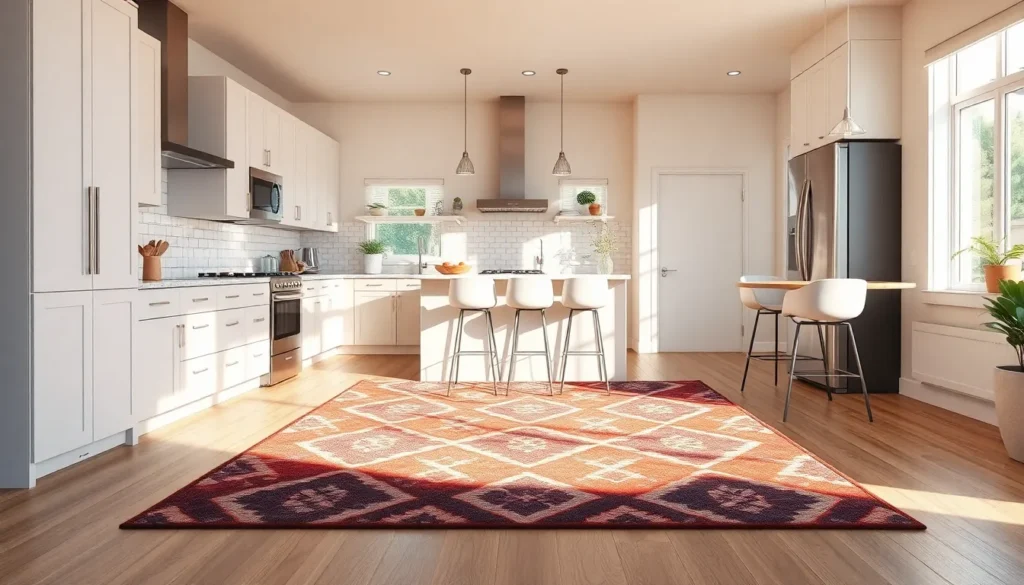We’ve all walked into a kitchen that felt cold and uninviting even though having beautiful countertops and modern appliances. The missing piece? A well-chosen kitchen rug that transforms the entire space from sterile to spectacular. Kitchen rugs aren’t just practical additions that cushion our feet during long cooking sessions – they’re powerful design elements that can tie together your kitchen’s aesthetic while providing comfort and functionality.
The right kitchen rug creates warmth underfoot while protecting your floors from spills and scratches. Whether you’re dealing with hardwood that needs extra protection or tile that feels harsh on bare feet, we’ll show you how to select rugs that complement your kitchen’s style and meet your practical needs.
From farmhouse-inspired jute runners to sleek modern patterns that make a statement, the perfect kitchen rug awaits. We’ll explore size considerations, material choices, and placement strategies that’ll elevate your kitchen’s design while keeping maintenance simple and stress-free.
Choose the Perfect Size for Your Kitchen Space
Selecting the right rug size makes all the difference between a cohesive kitchen design and a space that feels awkward or cramped. We’ll walk you through the essential measurements and considerations that ensure your kitchen rug enhances both style and functionality.
Measure Your Kitchen Layout First
Start by mapping out your kitchen’s dimensions using a tape measure to record the length and width of your available floor space. We recommend sketching a simple floor plan that includes major fixtures like islands, peninsulas, and dining areas to visualize where your rug will fit best.
Document the measurements of high-traffic zones such as the area in front of your sink, stove, and refrigerator where you spend the most time cooking and cleaning. Standard kitchen work zones typically measure 3 to 4 feet wide, which helps determine whether you need a runner or a larger area rug.
Record the distance between parallel counters to ensure your rug won’t interfere with cabinet doors or create tripping hazards. Most galley kitchens have 4 to 6 feet between counters, while L-shaped and U-shaped kitchens offer more flexibility for larger rug placements.
Consider Traffic Flow Patterns
Identify the main pathways people use when moving through your kitchen to avoid placing rugs in areas where they might bunch up or slide. We’ve found that mapping these routes helps you position rugs where they provide comfort without disrupting natural movement patterns.
Observe how family members navigate between the refrigerator, sink, stove, and prep areas during meal preparation to understand where rugs will be most beneficial. High-traffic cooking zones benefit from longer runners that span multiple work areas, while less-used corners can accommodate smaller accent rugs.
Consider doorway transitions where people enter and exit your kitchen to ensure your rug doesn’t create an obstruction. Rugs should sit at least 6 inches away from doorways to prevent interference with door swings and maintain smooth traffic flow.
Account for Cabinet and Appliance Clearance
Measure the swing radius of cabinet doors and dishwasher fronts to ensure your rug won’t prevent them from opening fully. Standard cabinet doors need 22 to 24 inches of clearance, while dishwashers require approximately 24 inches when fully extended.
Check refrigerator and oven door clearances by opening these appliances completely and marking where they extend into your floor space. French door refrigerators and wall ovens have different clearance requirements that affect rug placement in surrounding areas.
Verify that your rug edges sit at least 2 to 3 inches away from appliance bases to prevent interference with built-in units like ranges and refrigerators. This clearance also makes cleaning easier and prevents the rug from shifting when appliances vibrate during operation.
Select Durable Materials That Withstand Kitchen Demands
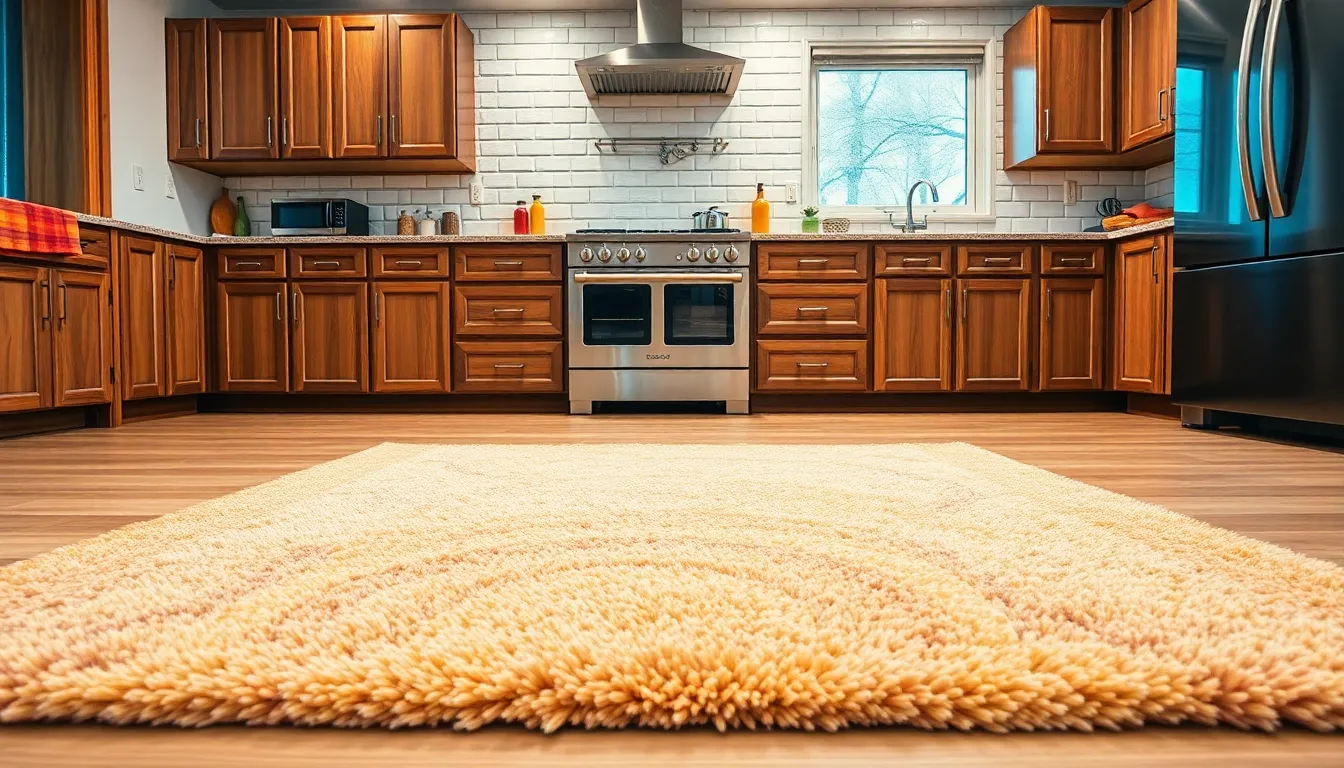
When choosing kitchen rugs, material selection becomes the foundation of both functionality and longevity. Kitchen environments present unique challenges with frequent spills, high traffic, and constant exposure to moisture that demand exact material properties.
Opt for Stain-Resistant Synthetic Fibers
Polypropylene rugs offer exceptional water resistance and non-toxic properties that make them perfect for kitchen environments. We recommend these rugs because they handle spills effortlessly and maintain their appearance through countless cleanings. Always air dry polypropylene rugs to prevent damage from high heat exposure.
Nylon kitchen rugs provide outstanding durability while resisting stains from common kitchen mishaps like coffee, wine, and cooking oils. These synthetic fibers bounce back from heavy foot traffic and maintain their texture longer than most alternatives.
Polyester options combine affordability with practical performance, offering stain resistance that protects against everyday kitchen accidents. Synthetic materials like nylon, polyester, and polypropylene are highly durable and suitable for high-traffic kitchens where messes happen frequently.
Choose Water-Resistant Natural Materials
Jute rugs bring an eco-friendly element to kitchen design while providing moderate durability for lighter use areas. Natural fibers like jute, sisal, or bamboo add organic texture but require more maintenance than synthetic alternatives.
Sisal kitchen rugs offer natural stain resistance with their tight weave construction that prevents spills from penetrating deep into fibers. These materials work well in kitchens with less intensive cooking activities.
Bamboo fiber rugs provide sustainable options that resist moisture better than traditional natural materials like cotton or wool. While less resistant to moisture than synthetic materials, these natural alternatives offer unique aesthetic appeal for environmentally conscious homeowners.
Avoid High-Maintenance Fabrics
Silk rugs require professional cleaning and delicate handling that makes them impractical for kitchen environments where spills occur regularly. We strongly advise against using silk in areas where food preparation creates frequent cleaning challenges.
Velvet materials trap particles and stains easily, making routine maintenance difficult and time-consuming. These delicate fabrics can be difficult to clean and maintain in busy kitchen settings.
Wool rugs, while naturally stain-resistant and long-lasting, show sensitivity to moisture that limits their kitchen applications. Instead, opt for materials that are easy to clean and resistant to stains and moisture for optimal kitchen performance.
Explore Timeless Neutral Kitchen Rug Ideas
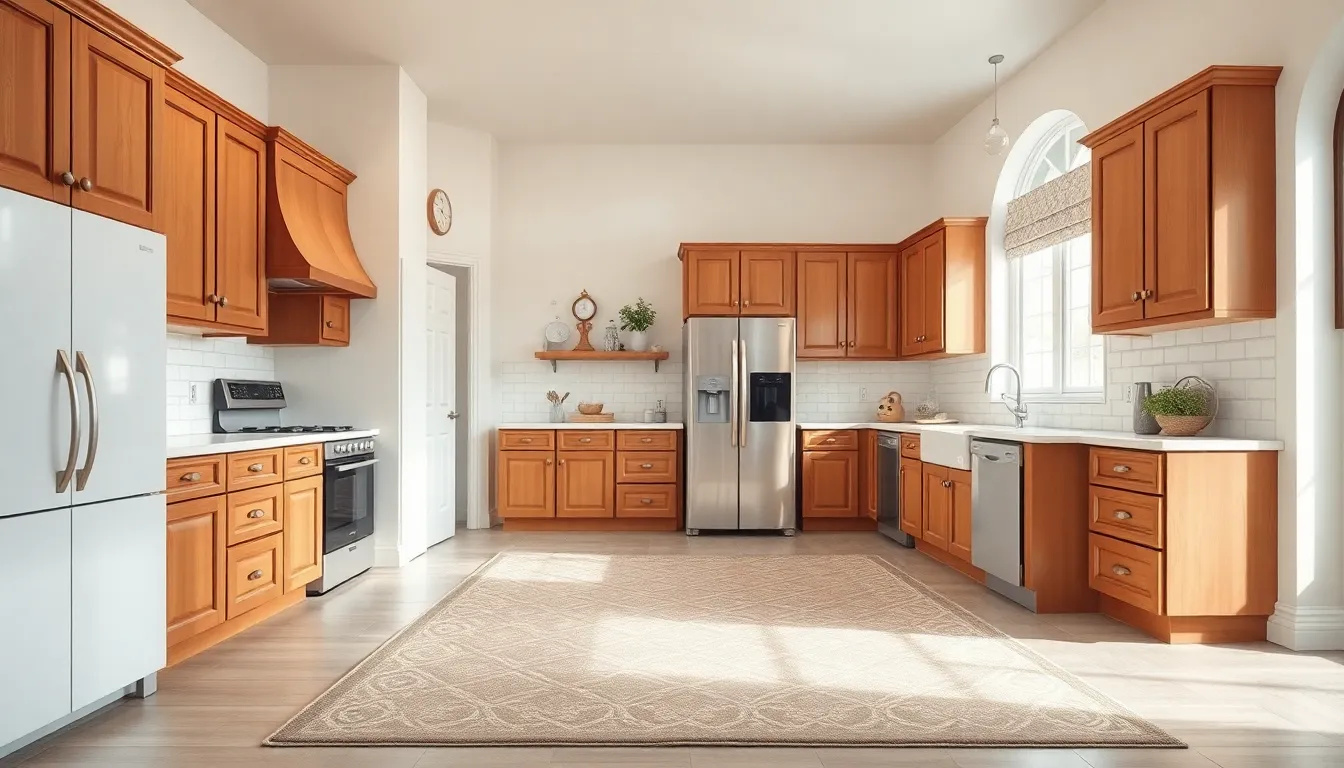
Neutral kitchen rugs offer the perfect foundation for creating a sophisticated and cohesive design that stands the test of time. These versatile options seamlessly integrate with existing decor while providing the durability and style your kitchen demands.
Classic Beige and Cream Options
Beige rugs create an instantly welcoming atmosphere that blends effortlessly with traditional kitchen styles. These warm neutrals complement wood cabinets, stone countertops, and brass fixtures while maintaining their timeless appeal across various design trends.
Cream colored rugs add elegant sophistication to any kitchen space, particularly when paired with white or light colored cabinetry. We recommend these lighter tones for kitchens with darker flooring, as they create beautiful contrast while softening harsh lines. Natural fiber cream rugs work exceptionally well in farmhouse and cottage style kitchens, bringing textural interest without overwhelming the space.
Sophisticated Gray Tones
Gray rugs deliver modern sophistication that elevates contemporary kitchen designs. These versatile neutrals pair beautifully with stainless steel appliances, quartz countertops, and sleek cabinetry while creating a clean, minimalist aesthetic.
Charcoal and slate gray options provide depth and visual interest in predominantly white kitchens. We find that medium gray tones work particularly well as transition pieces, connecting different design elements throughout your kitchen space. Light gray rugs complement bold accent colors like navy blue, emerald green, or warm terracotta, making them ideal for kitchens featuring colorful backsplashes or statement pieces.
Versatile Black and White Patterns
Black and white rugs offer timeless elegance that transcends design trends and style preferences. These classic combinations work equally well in modern minimalist kitchens and traditional farmhouse spaces, providing visual interest without competing with other design elements.
Geometric black and white patterns create striking focal points that draw the eye while maintaining neutral versatility. We particularly love checkerboard patterns for vintage inspired kitchens and stripe designs for contemporary spaces. These high contrast rugs effectively define different zones within open concept kitchen layouts while providing practical benefits like hiding minor stains and dirt between cleanings.
Add Personality With Bold Pattern Kitchen Rugs
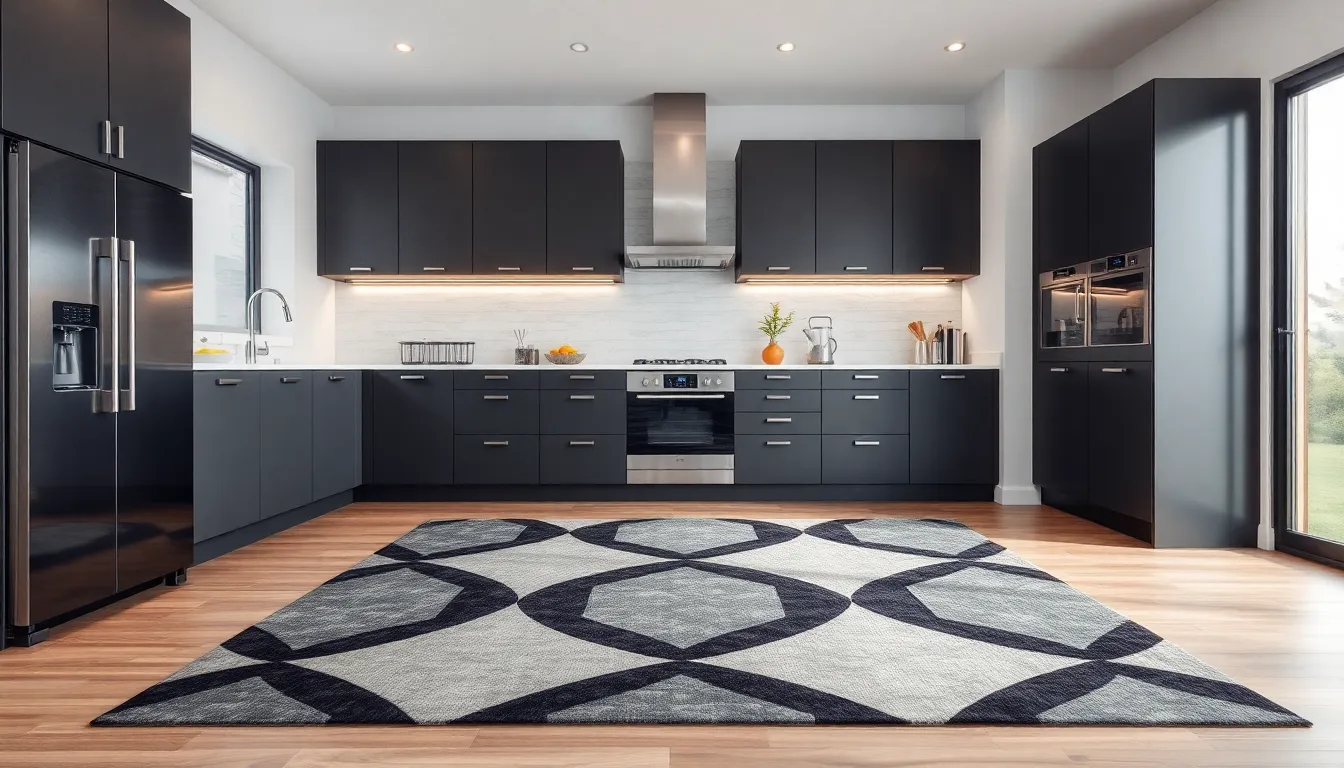
Bold patterns transform ordinary kitchens into ever-changing spaces that reflect our personal style and design preferences. These eye-catching designs serve as artistic focal points while maintaining the practical benefits we need in high-traffic cooking areas.
Geometric Designs for Modern Kitchens
Geometric patterns like hexagons, diamonds, and chevrons perfectly complement modern cabinetry and contemporary tiling designs. These structured shapes create visual rhythm throughout the space while maintaining the clean lines that define modern kitchen aesthetics.
Neutral geometric rugs in black, grey, taupe, or beige colors maintain our modern design goals while adding essential warmth to potentially cold surfaces. We can achieve stunning textural contrast by pairing smooth kitchen floors with lightly ribbed or looped geometric rugs that add visual interest without disrupting our established color schemes.
Modern kitchens benefit from monochrome geometric rugs that blend seamlessly into the space without competing with existing fixtures and appliances. These minimalist patterns work exceptionally well in Scandinavian-inspired kitchens where simplicity and functionality take priority.
Floral Motifs for Traditional Spaces
Classic floral patterns bring timeless elegance to traditional kitchen designs, especially when we pair them with wooden elements or vintage-inspired fixtures. These intricate motifs create sophisticated visual layers that enhance the warmth and character of traditional cooking spaces.
Vintage Persian rugs with elaborate floral designs add sophisticated charm through their rich colors and detailed craftsmanship. We can use these statement pieces to anchor our traditional kitchen design while introducing luxurious textures that elevate the entire space.
Traditional floral motifs work beautifully in kitchens with classic color palettes, wooden cabinetry, and vintage hardware that emphasize craftsmanship and attention to detail.
Striped Patterns for Transitional Style
Striped patterns offer remarkable versatility by blending seamlessly with both modern and traditional kitchen elements. We can find these adaptable designs in various colors and widths to perfectly suit different decorating themes and personal preferences.
Braided cotton rugs featuring striped patterns provide a cozy, homespun appearance while delivering the durability we need for busy kitchen environments. These natural fiber options combine comfort with practicality, making them ideal choices for families who prioritize both style and function.
Transitional kitchens benefit from striped rugs that bridge the gap between contemporary minimalism and traditional warmth, creating balanced spaces that feel both current and timeless.
Consider Color Coordination With Your Kitchen Decor
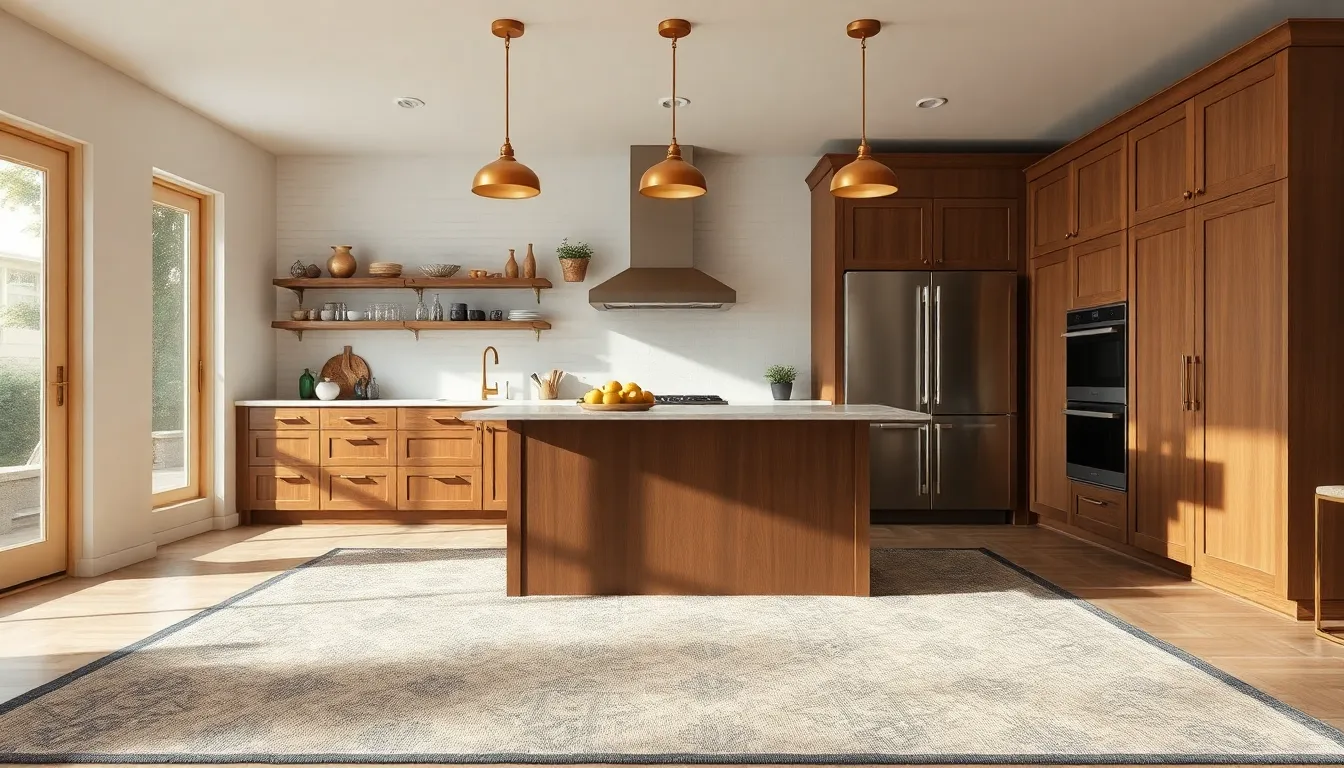
Choosing kitchen rugs that complement your existing decor creates a unified design that feels intentional and polished. Color coordination ties together various elements in your kitchen space while improving both aesthetics and functionality.
Match Your Cabinet Hardware and Fixtures
Drawing inspiration from your cabinet hardware, faucets, and light fixtures creates visual continuity throughout your kitchen. Brushed nickel or matte black fixtures pair beautifully with rugs featuring subtle metallics or dark accents that echo these finishes.
Coordinating the style of your rugs with the finish and era of your hardware ensures design harmony. Modern kitchens benefit from rugs with clean lines and contemporary patterns, while traditional spaces look best with classic designs that reflect the timeless appeal of your cabinet pulls and knobs.
Light fixtures provide another excellent reference point for rug selection. Pendant lights with warm brass finishes complement rugs in earthy tones like cream, beige, or soft gold accents that create a cohesive color story.
Complement Your Backsplash Design
Selecting rugs that echo the colors or patterns found in your backsplash creates visual balance in your kitchen. Geometric backsplashes work wonderfully with rugs featuring complementary geometric patterns or relevant color accents that tie the floor to the wall elements.
Solid colored rugs provide visual rest when your backsplash features busy patterns or bold tiles. This approach prevents the space from feeling overwhelming while maintaining design interest through contrasting textures and materials.
Plain backsplashes offer opportunities to introduce patterned rugs that add visual interest to your kitchen floor. Subtle patterns in colors that complement your backsplash tile create depth without competing for attention.
Coordinate With Window Treatments
Ensuring your rug’s color and pattern coordinate with curtains, blinds, or valances creates balance between floor and window areas. This coordination makes your kitchen feel unified and thoughtfully designed from top to bottom.
Multiple textiles work best when they maintain the same color family or introduce a shared accent hue for cohesive appeal. Warm neutrals like ivory, cream, or beige provide versatile foundations that blend seamlessly with various window treatment styles.
Window treatments in bold patterns pair effectively with solid colored rugs that ground the space without visual competition. Conversely, simple window coverings allow patterned rugs to take center stage while maintaining overall design harmony.
Maximize Comfort With Cushioned Kitchen Rug Options
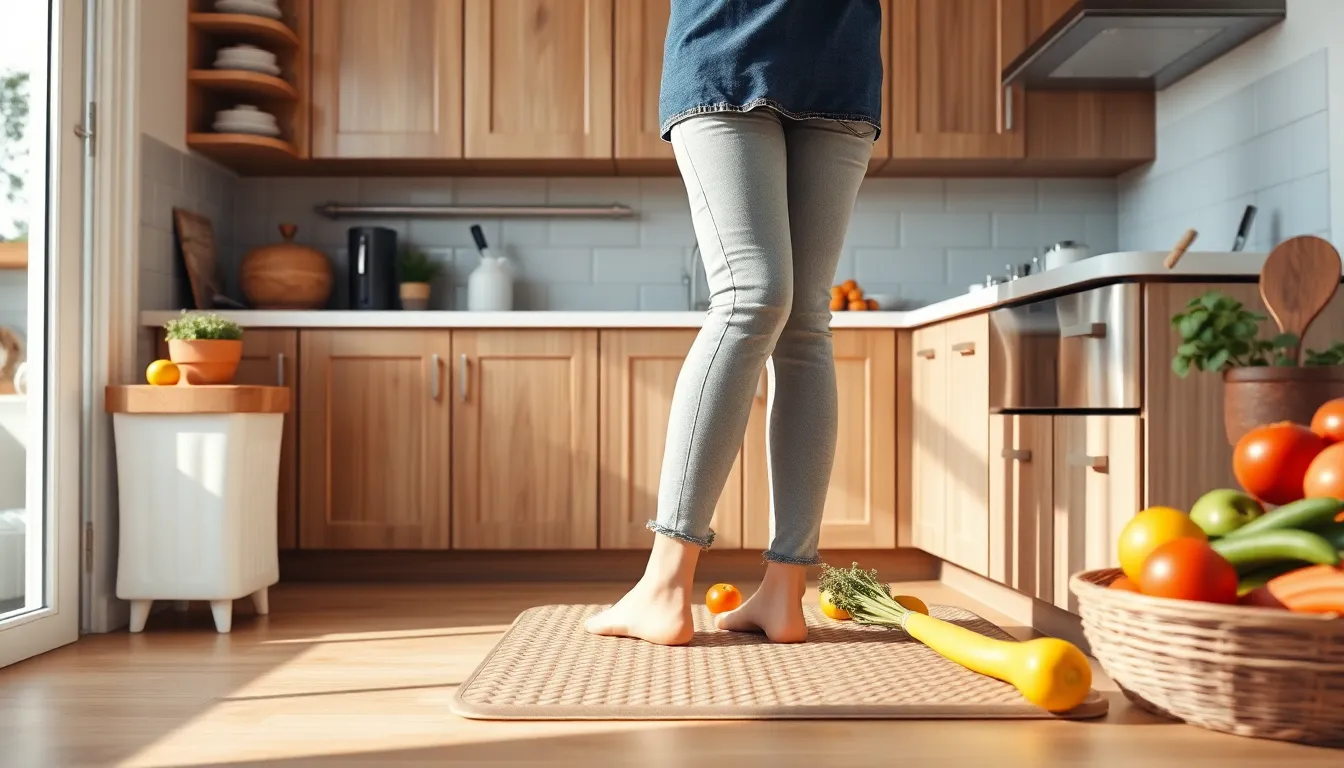
Standing for extended periods while cooking can take a toll on your body, but the right cushioned kitchen rug transforms your cooking experience into a comfortable one. We’ve discovered that cushioned options provide essential support that makes all the difference during meal preparation.
Memory Foam Backing Benefits
Memory foam kitchen rugs contour to your body weight and distribute pressure evenly across your feet. This specialized backing material adapts to your unique stance, providing consistent support throughout extended cooking sessions. We find that memory foam’s ability to respond to individual weight distribution helps maintain proper posture while you work.
Circulation improves significantly when you use memory foam backed rugs during long cooking periods. The foam’s supportive properties reduce strain on your feet, legs, and back by cushioning pressure points. Enhanced blood flow means less fatigue and more enjoyable time spent preparing meals for your family.
Recovery happens faster with memory foam backing because it slowly returns to its original shape after use. This resilient quality ensures consistent comfort level over time, making these rugs a worthwhile investment for busy kitchens. High density foam construction provides the durability needed for daily kitchen activities.
Gel-Filled Mat Advantages
Gel filled kitchen mats offer a cooling sensation that feels like stepping on a cloud. This unique material provides deep, responsive cushioning that professionals and home cooks favor for its superior comfort properties. We notice that gel technology delivers immediate pressure relief the moment you step onto the surface.
Temperature regulation sets gel filled mats apart from traditional foam options. The cooling effect helps prevent heat buildup during intense cooking sessions, keeping your feet comfortable even when kitchen temperatures rise. This feature proves especially valuable during summer months or when using heat generating appliances.
Responsiveness characterizes gel technology’s ability to adapt quickly to movement and weight shifts. The material bounces back instantly, providing consistent support whether you’re standing in one spot or moving around your kitchen workspace. Durability remains exceptional even with frequent use in high traffic cooking areas.
Anti-Fatigue Features for Long Cooking Sessions
Anti fatigue mats are engineered with thick, resilient foam or gel layers that reduce physical stress from prolonged standing. These specialized designs help minimize lower back pain and joint discomfort during food preparation or dishwashing activities. We observe that proper anti fatigue features can increase endurance significantly during extended cooking periods.
Circulation benefits improve dramatically when using mats designed specifically for fatigue reduction. The supportive layers promote better blood flow to your feet and legs, preventing the numbness and discomfort associated with standing on hard kitchen floors. Enhanced circulation means you can cook longer without experiencing typical fatigue symptoms.
Safety features complement comfort in modern anti fatigue kitchen mats. Non slip surfaces prevent accidents while waterproof materials resist spills and splashes common in kitchen environments. Easy to clean surfaces maintain hygiene standards while remaining free from harmful chemicals like PVC, formaldehyde, and latex for family safety.
Prioritize Easy Maintenance and Cleaning Requirements
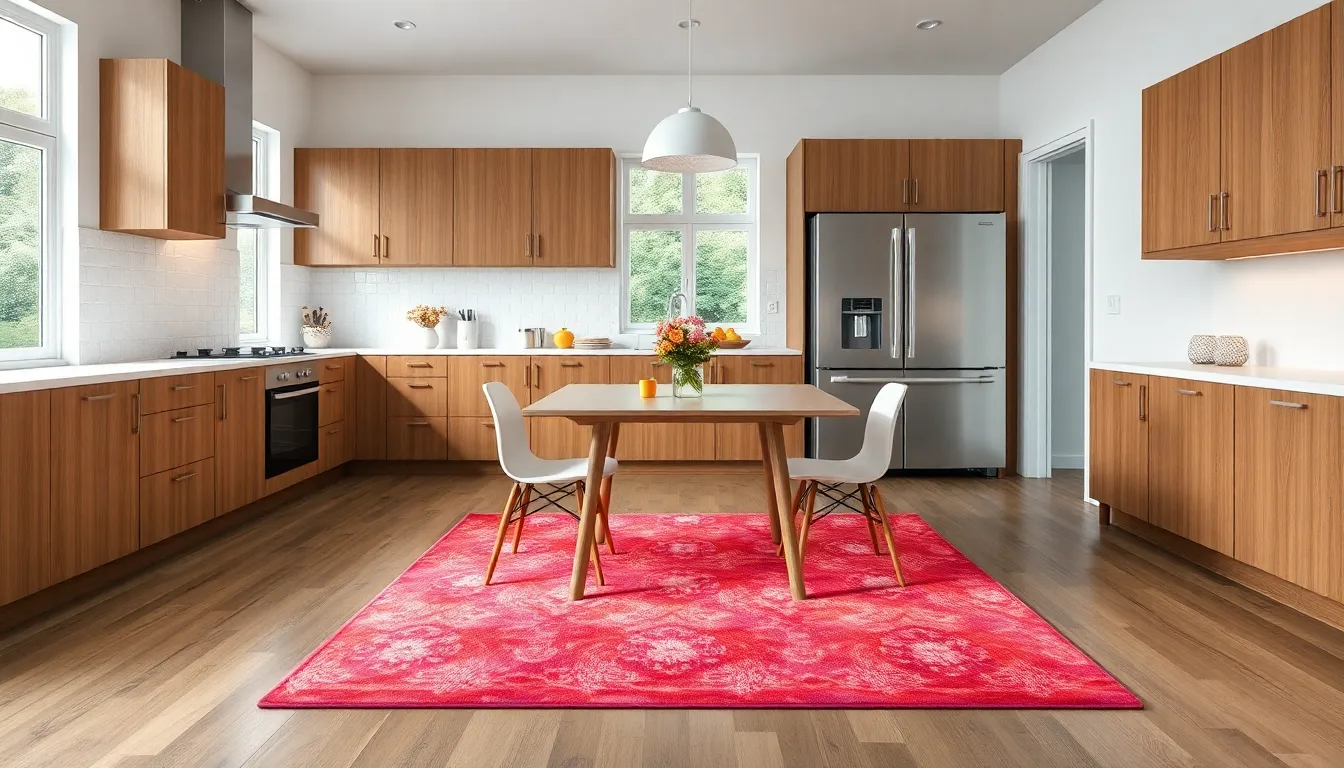
Kitchen environments demand rugs that can handle spills, food particles, and constant foot traffic without compromising style or requiring excessive upkeep.
Machine-Washable Rug Benefits
Machine washable rugs transform kitchen maintenance from a chore into a simple laundry task. We can easily toss these rugs into our washing machine alongside regular laundry, eliminating the need for professional cleaning services or time-consuming hand scrubbing. Busy households with children or pets particularly benefit from this convenience, as spills and accidents become manageable rather than stressful situations.
Regular washing cycles effectively remove food particles, grease stains, and pet hair that accumulate over time. Machine washable options maintain their fresh appearance with minimal effort, allowing us to focus on cooking and entertaining rather than rug maintenance. These rugs also offer peace of mind during meal preparation, knowing that any mess can be quickly resolved with a trip to the washing machine.
Spot-Clean Friendly Materials
Performance materials revolutionize kitchen rug functionality by resisting stains while maintaining their appearance through multiple cleanings. Polypropylene leads the pack with exceptional stain resistance and lightweight construction that won’t buckle or shift during daily use. Recycled polyester offers eco-conscious homeowners a sustainable option that performs equally well against kitchen mishaps.
Microfiber blends excel at repelling liquids and releasing dirt particles during cleaning cycles. Cotton polyester hybrids combine natural comfort with synthetic durability, creating surfaces that handle everything from coffee spills to pasta sauce splatters. These materials retain their color vibrancy and structural integrity even after repeated washing, ensuring long-term value for our investment.
Flatweave and low-pile designs work best with these materials because they don’t trap crumbs or debris in deep fibers. This construction reduces tripping hazards while making cleanup more efficient between washing sessions.
Quick-Dry Options for Busy Kitchens
Quick drying capabilities keep our kitchens functional during rug cleaning cycles by minimizing downtime. Performance fabrics engineered for moisture resistance allow us to return freshly washed rugs to their positions within hours rather than days. This rapid turnaround prevents disruption to our cooking routines and maintains the comfort we expect underfoot.
Advanced textile technology creates materials that wick moisture away from surfaces while allowing air circulation through the rug structure. Many modern options feature removable covers that separate from backing materials, enabling us to wash only the surface layer when needed. Single unit designs streamline the process further by eliminating multiple components while still achieving fast drying times.
These innovations particularly benefit households that cook frequently or entertain regularly, where rug downtime must be minimized to maintain kitchen functionality and aesthetics.
Position Kitchen Rugs for Optimal Function and Style
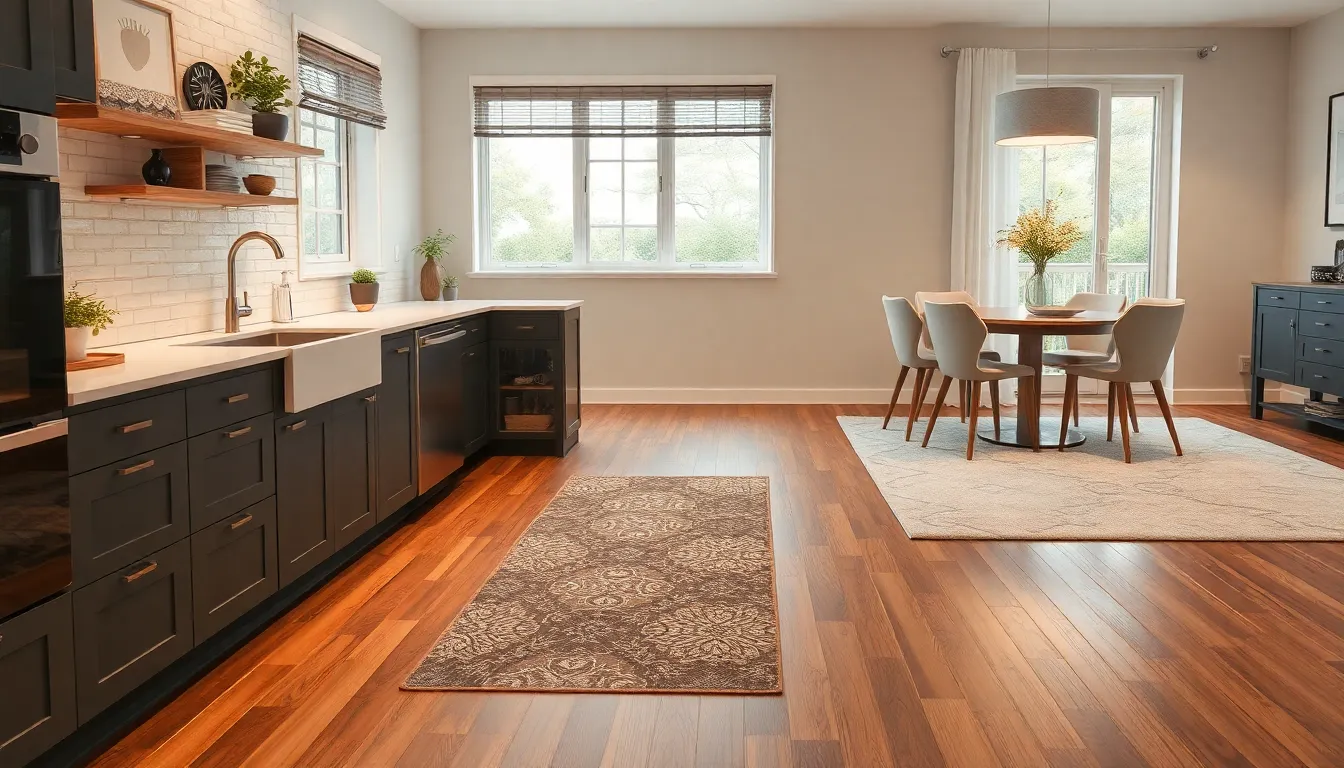
Strategic rug placement transforms your kitchen’s functionality while elevating its aesthetic appeal. We’ll explore essential positioning techniques that maximize both comfort and visual impact.
Strategic Placement Near High-Traffic Areas
Positioning rugs in front of the sink creates an ideal comfort zone during dishwashing tasks while catching water splashes that could create slip hazards. We recommend selecting water-resistant materials that complement your kitchen’s existing decor for this high-moisture area.
Placing rugs under dining tables defines eating spaces beautifully in open-plan kitchens while adding warmth to the overall design. Make sure your rug extends far enough to accommodate chairs when they’re pulled out from the table.
Installing rugs beneath portable islands or tables protects your flooring from scratches and damage while creating a cozy atmosphere. The perfect sizing means your rug should extend 1-2 feet beyond the island on each side for optimal proportion.
Adding accent rugs in front of stoves or prep counters provides comfort during food preparation while introducing visual interest to work zones. These smaller rugs offer targeted comfort exactly where you need it most.
Layering Techniques for Visual Interest
Combining multiple rugs creates sophisticated layered looks while improving functionality throughout your kitchen space. Runners paired with area rugs allow for easy cleaning and seasonal swapping to refresh your design.
Varying rug thicknesses based on exact locations optimizes both comfort and practicality in different zones. Thicker rugs work exceptionally well in standing areas like stove fronts, while thinner options near sinks dry quickly after water exposure.
Creating defined zones with strategically layered rugs helps organize open kitchen layouts while maintaining visual flow. This technique works particularly well in larger kitchens where you want to establish distinct functional areas.
Safety Considerations for Slip Prevention
Selecting water-resistant materials prevents moisture absorption that leads to slipping hazards in kitchen environments. These specialized materials maintain their grip even when exposed to occasional spills and splashes.
Installing rug pads beneath every kitchen rug secures them firmly in place while reducing slip risks significantly. Quality rug pads also extend your rug’s lifespan by preventing bunching and premature wear.
Choosing appropriate textures ensures your rugs provide traction without creating tripping hazards for family members and guests. Low-profile edges and stable weaves offer the safest options for busy kitchen traffic patterns.
Conclusion
We’ve explored the essential elements that make kitchen rugs both functional and stylish additions to your culinary space. From selecting the right size and material to choosing between timeless neutrals and bold patterns your rug choice can significantly impact your kitchen’s overall design and comfort level.
Remember that the best kitchen rug balances durability with aesthetics while meeting your exact maintenance preferences. Whether you opt for cushioned comfort or prioritize easy cleaning your investment should enhance both the visual appeal and practical functionality of your kitchen.
With proper placement and thoughtful selection your kitchen rug will serve as a foundation piece that ties together your design elements while providing the comfort and protection your hardworking kitchen deserves.
Frequently Asked Questions
What are the benefits of using kitchen rugs?
Kitchen rugs provide both aesthetic and functional benefits. They transform cold spaces into warm, welcoming environments while offering comfort underfoot during long cooking sessions. Additionally, they protect flooring from spills and scratches, reduce noise, and can serve as decorative focal points that enhance your kitchen’s overall design.
How do I choose the right size kitchen rug?
Measure your kitchen layout, including high-traffic zones and distances between counters. Consider traffic flow patterns to avoid areas where rugs might bunch up or slide. Account for cabinet and appliance clearance, ensuring the rug fits comfortably without interfering with door openings or walkways.
What materials are best for kitchen rugs?
Synthetic fibers like polypropylene, nylon, and polyester are ideal due to their stain resistance and durability. Natural materials like jute and sisal offer eco-friendly options. Avoid high-maintenance fabrics like silk and wool, which can be difficult to clean and maintain in kitchen environments.
Should I choose neutral or patterned kitchen rugs?
Both options have merit. Neutral rugs in beige, cream, or gray create sophisticated, versatile designs that complement various styles. Bold patterned rugs with geometric, floral, or striped designs add personality and serve as artistic focal points while reflecting your personal style.
How do I coordinate my kitchen rug with existing decor?
Match your rug with cabinet hardware, fixtures, and lighting for visual continuity. Echo backsplash designs for balance and coordinate with window treatments to create a cohesive look. The rug should complement existing color schemes rather than clash with your kitchen’s overall aesthetic.
What are cushioned kitchen rugs and their benefits?
Cushioned kitchen rugs feature memory foam or gel-filled backing that provides support during extended standing periods. They improve circulation, reduce fatigue, and offer pressure relief. These rugs are particularly beneficial for busy cooks who spend significant time preparing meals.
Are kitchen rugs easy to maintain?
Yes, when you choose the right materials. Machine-washable rugs simplify maintenance, while spot-clean friendly materials like polypropylene resist stains. Quick-dry options with moisture-resistant technology minimize downtime and ensure your kitchen remains functional during cleaning processes.
Where should I place kitchen rugs for maximum effectiveness?
Position rugs in high-traffic areas like in front of sinks, stoves, and under dining tables. These placements create comfort zones and protect flooring. Consider layering techniques for visual interest and always use rug pads for safety and stability to prevent slipping.

